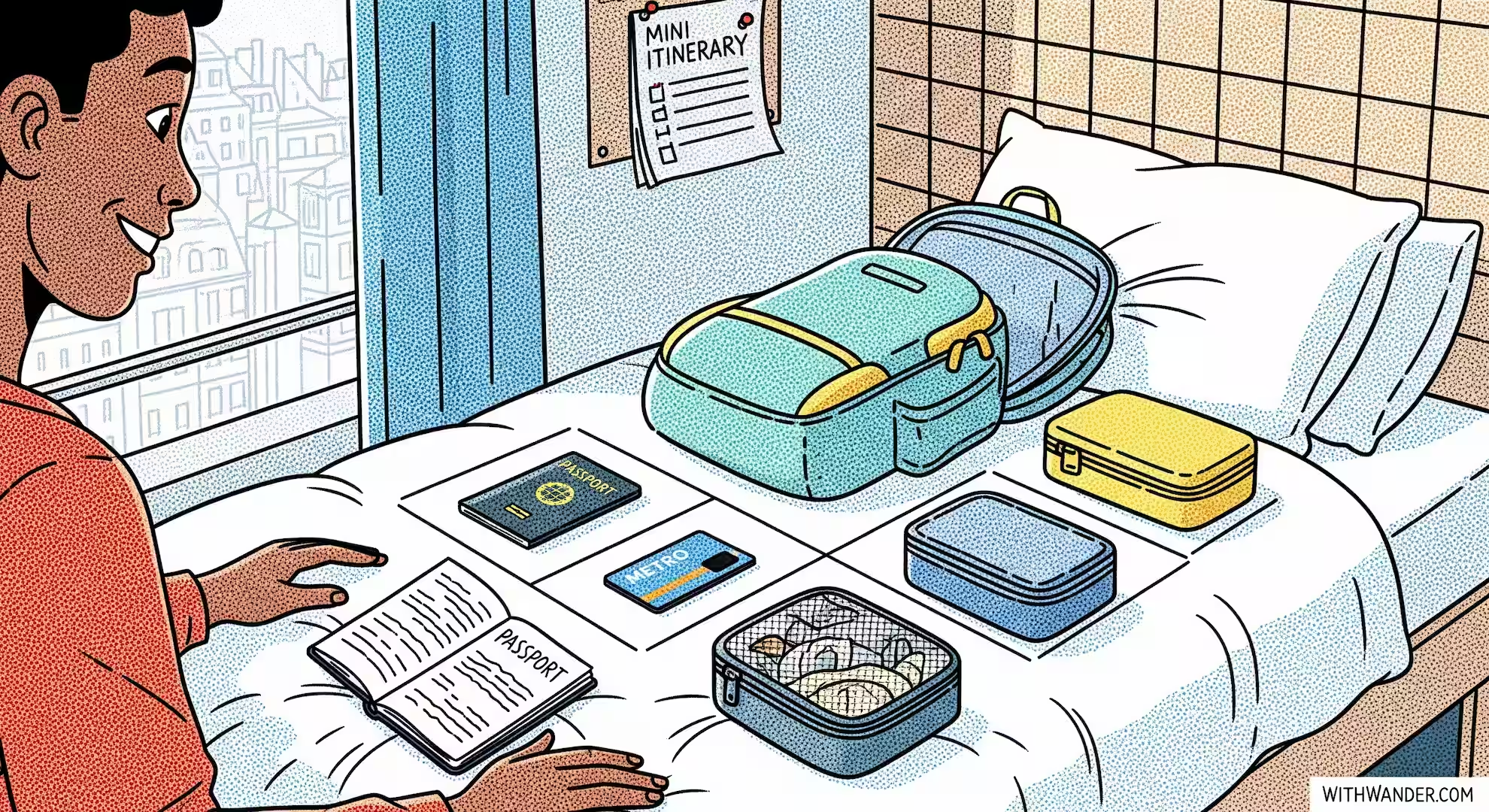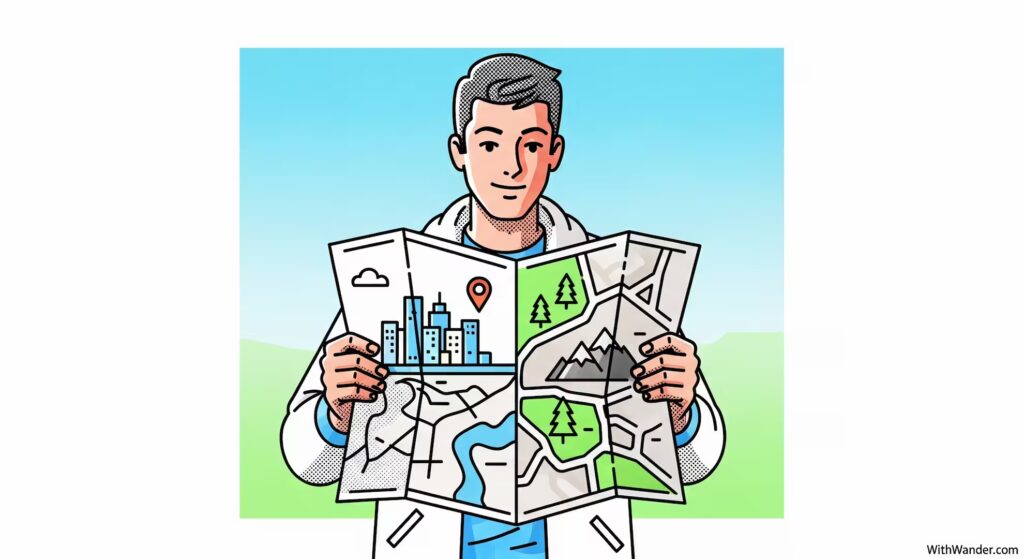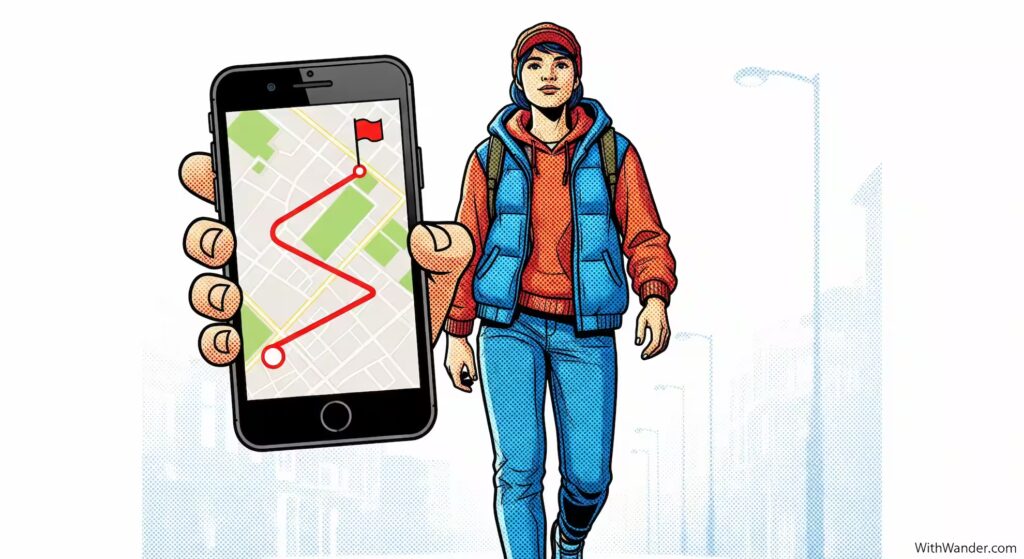INDEX
I remember standing at Barcelona’s El Prat airport on my first solo trip, feeling a mix of pure excitement and a little bit of fear. That feeling is normal.
Planning your first time solo travel Europe is a huge step, one filled with questions about budget, safety, and just how to do it all without feeling overwhelmed.
This guide is built from my own experiences crossing the continent alone. I’ll give you practical, straightforward advice to save money, stay safe, and make your adventure exactly what you want it to be.
We’ll cover everything from getting around cheaply to finding great hostels and balancing your itinerary.
Preparing for Your First Time Solo Travel Europe

The most important preparation happens before you even book a flight. It’s about setting your expectations and getting your gear in order. A successful solo trip is 90% mindset and 10% knowing a few good tricks.
Your first independent adventure is a chance to prove to yourself how capable you are. Along with planning your itinerary, taking the time for practical steps like preparing your house for a long trip will give you invaluable peace of mind. Let’s get the fundamentals right so you can focus on the experience.
Flexibility is your best friend, so don’t overschedule every minute.
Things will go wrong – a missed train, a rainy day. That’s part of the story.
Learn to enjoy your own company at a cafe or a park bench.
Be open to talking to strangers; it’s how the best memories are made.
Track your spending for a month at home to see where your money goes.
Budget €75-€125 per day for Western Europe, €40-€90 for Eastern Europe.
This should cover your bed, food, transport, and a few sights.
Always have a backup credit card and some emergency cash stashed away.
A 40-liter backpack is perfect; anything bigger is a burden.
Packing cubes are non-negotiable for organization.
Bring one pair of comfortable, broken-in walking shoes.
Pack for one week and plan to do laundry on the road.
What Is the Cheapest Way to Get Around Europe?

This is the big question for every budget traveler. While flying seems fast, it often isn’t the most cost-effective or scenic option. For your first time solo travel Europe, understanding your transport choices is key to stretching your budget further.
I’ve learned that a mix-and-match approach works best. Buses are great for shorter distances within a country, while trains offer comfort and amazing views for cross-border trips.
This is your cheapest bet, hands down.
Great for trips under 5-6 hours, like Prague to Vienna.
Book a week or two ahead for the best prices, often under €15.
Downside: can be slow and less comfortable than trains.
More expensive than buses, but faster and much more comfortable.
Stations are usually right in the city center, saving time and money.
Booking in advance is critical for high-speed routes to get good fares.
A rail pass (like Eurail) is only worth it if you’re moving every few days.
Best for covering long distances, like Lisbon to Rome.
The ticket price is low, but watch out for baggage fees—they’ll get you.
Airports are often far from the city, adding extra transport costs.
Factor in security and transit time; it’s often a half-day affair.
How to Find Good Affordable Hostels in Europe

Hostels are the heart of the solo travel experience. They are more than just a cheap bed; they are social hubs where you’ll meet people from all over the world. But not all hostels are created equal.
Finding a place that is clean, safe, social, and affordable requires a little research. I rely on recent reviews and look for specific features that make a big difference in comfort and security.
💡My Go-To Booking Platform
I almost exclusively use Hostelworld for my bookings. Its review system is reliable because only people who have completed a stay can leave a comment. The filters for “free breakfast” or “common room” are extremely useful.
Here’s my personal checklist for vetting a hostel before I book.
My Hostel Booking Checklist:
Look for recent comments on cleanliness and atmosphere.
Older reviews might not reflect the current management.
A rating of 8.5 or higher is usually a safe bet.
Pay attention to mentions of bed bugs—a definite deal-breaker.
In-room lockers are an absolute must for security.
24-hour reception is important if you have a late arrival.
A kitchen saves a ton of money on food.
Free Wi-Fi in the rooms, not just the lobby, is a big plus.
Use Google Maps to check proximity to public transport.
Is it in a safe, well-lit neighborhood? Read reviews mentioning the area.
Being central costs more but saves you transport fees and time.
Check if it’s near a supermarket for cheap meals.
Is It Safe to Stay in Hostels in Europe Alone?

Yes, staying in hostels in Europe alone is generally very safe, provided you take standard precautions. Hostels are designed for travelers, and security is a top priority for any reputable establishment.
Millions of people, including many solo female travelers, stay in hostels every year without incident. The key is to choose your hostel wisely and use common sense, just as you would in any other public space.
You’re surrounded by other travelers, so you’re never truly alone.
Staff are used to solo travelers and can offer local safety tips.
Many hostels organize group activities, which are great for exploring safely.
There’s a sense of community; people look out for each other.
Petty theft is the main risk, so always use your locker.
You’re sharing a room with strangers; trust your gut instinct.
Noise can be an issue, so bring earplugs for a good night’s sleep.
Female travelers can opt for female-only dorms for extra comfort.
How to Balance Cities and Nature on a Europe Trip

It’s easy to get caught up in a whirlwind of capital cities and forget that Europe has some of the most beautiful and accessible nature in the world. For your first time solo travel Europe, building in time for nature is vital to avoid burnout.
My favorite strategy is to base myself in a city and take day trips to nearby national parks or coastal areas. This gives you the best of both worlds: the social energy of the city at night and the peace of the outdoors during the day.
🌍Example Itinerary: Prague to Berlin
Spend 3 days exploring Prague’s history, then take a day trip to the stunning rock formations of Bohemian Switzerland National Park. From there, travel to Berlin for 3 days of art and culture, with a relaxing day trip paddling through the canals of the Spreewald Forest.
Here are some great city-to-nature pairings to inspire you.
-
Munich, Germany → The Alps
Base in Munich. (Train to Garmisch-Partenkirchen: approx. €26, 90 mins). Hike stunning trails with classic Alpine views, easily accessible for a day trip.
-
Lisbon, Portugal → Sintra-Cascais Natural Park
Base in Lisbon. (Train to Cascais: approx. €5, 40 mins). Explore dramatic coastal cliffs and sandy beaches just a short train ride from the city’s hustle.
My 7 Essential Money-Saving Hacks
These are the strategies I use on every trip to make my budget last longer. They are simple, effective, and will save you hundreds of euros over a multi-week trip.
Hack #1: Master the Art of the Free Walking Tour

On my first day in any new city, I join a free walking tour. They are offered in almost every major European city and are a fantastic way to get your bearings, learn some history, and meet other travelers. You only tip the guide what you feel the tour was worth at the end.
Hack #2: Cook Your Own Meals
Eating out three times a day will destroy your budget. Booking hostels with kitchens is a non-negotiable for me. I save a huge amount of money by eating breakfast at the hostel and often packing a sandwich for lunch.
💡The Supermarket Challenge
Try making a meal for under €5 using ingredients from a local supermarket. It’s a fun way to experience local products and save cash. A simple pasta dish or a fresh salad can be incredibly satisfying and cheap.
Hack #3: Travel During the Shoulder Season

Avoid the peak summer months of July and August. The “shoulder seasons” — April to June and September to October — offer the perfect balance. You’ll find pleasant weather, fewer crowds, and significantly lower prices for flights and accommodation.
Hack #4: Use Public Transport Like a Local
Skip the expensive taxis and sightseeing buses. Figure out the local public transport system. For a major hub, a dedicated guide to Rome public transport can be a lifesaver. Buying a 24-hour or 3-day pass is almost always cheaper than buying single tickets if you plan to make more than two trips a day.
- Berlin AB Day Pass:Unlimited travel. €10.60. A single ticket is €3.80.
- Rome 24-Hour Pass:Bus, tram, metro. €8.50. A single ticket is €1.50.
Hack #5: Pack Smart to Avoid Fees

Budget airlines are notorious for their strict and expensive baggage policies. Invest in a good quality carry-on backpack that meets the size requirements of airlines like Ryanair and EasyJet. Packing light is a skill that saves you money and back pain.
Hack #6: Find Free Museum Days
Many of Europe’s top museums offer free admission on certain days of the month or during specific evening hours. A quick search before you visit can save you a lot of money on entrance fees.
The Prado in Madrid is free in the evenings, a real treat!
Check the specific hours, usually the last two before closing.
Paris museums are free on the first Sunday of the month.
This is a great deal, but expect big crowds on those days.
Hack #7: Get a Wise or Revolut Card

Don’t let bank fees eat up your budget. Cards from services like Wise or Revolut allow you to hold multiple currencies and offer excellent exchange rates. You’ll save a fortune on ATM withdrawal fees and currency conversion charges compared to using your regular bank card.
FAQs: Your Questions on Solo European Travel

What’s the best first country for solo travel in Europe?
Portugal is a fantastic choice. It’s affordable, safe, has a great hostel scene, and English is widely spoken. The locals are incredibly welcoming, which makes it easy to navigate your first solo trip. Ireland is another excellent option for similar reasons.
How much money do I need for a month of solo travel in Europe?
A reasonable budget is between €1,800 and €3,000 for one month. In Eastern Europe (e.g., Poland, Hungary), you can comfortably manage on €60/day. In more expensive Western European countries (e.g., France, Italy), you should budget closer to €90-€100/day. This covers hostels, food, local transport, and activities.
Should I get a Eurail pass?
A Eurail pass is only worth the cost if you plan on taking many long-distance train journeys across multiple countries in a short period. If your itinerary involves shorter trips, budget flights, or a lot of bus travel (especially in the Balkans), it’s almost always cheaper to buy tickets point-to-point in advance.
How do I pack light for a solo trip in Europe?
Stick to a 40-liter backpack to keep things manageable. The best strategy is to pack enough clothes for one week and plan to do laundry on the road. Using packing cubes is essential for staying organized.
Are hostels safe, especially for solo female travelers?
Yes, hostels are generally very safe. The main risk is petty theft, so always use the lockers provided for your valuables. For added comfort, many hostels offer female-only dormitories, which are a great option for solo female travelers.
What are some quick ways to save money every day while traveling?
The two biggest daily savings come from food and transport. Cook your own meals at the hostel kitchen instead of eating out, and use local public transport passes instead of taxis. Joining a free walking tour is another great way to explore a city without spending much.
When is the best time of year to go for a first solo trip to Europe?
The shoulder seasons—April to June and September to October—are ideal. You’ll find pleasant weather, fewer crowds, and lower prices for flights and accommodation compared to the peak summer months of July and August.
How do I avoid getting burned out from visiting too many cities?
A great strategy is to base yourself in a major city and plan day trips to nearby national parks, coastal areas, or smaller towns. This allows you to enjoy the social aspects of a city while also getting a break in nature, preventing travel fatigue.
